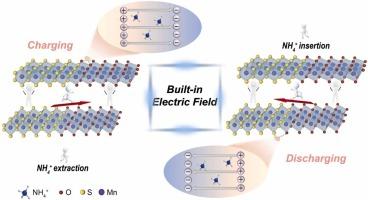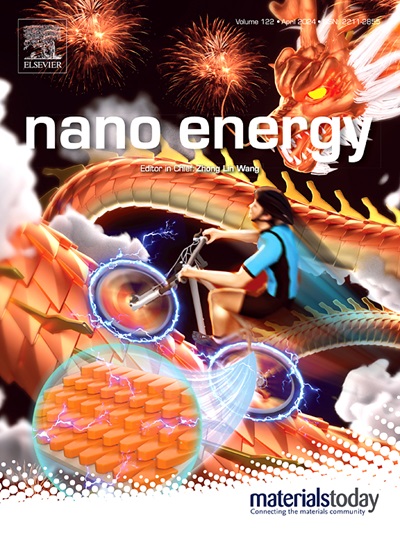P-n junction built-in electric field and electrochemical in-situ intercalation enabled ultra-stable and high-energy ammonium-ion storage
IF 16.8
1区 材料科学
Q1 CHEMISTRY, PHYSICAL
引用次数: 0
Abstract
Ammonium-ion (NH4+) is a promising non-metallic charge carrier in aqueous energy storage with sustainability and environmental benignity. In spite of the unique H-bond mechanism between NH4+ and host material, the anisotropy caused from tetrahedral structure of NH4+ essentially limits its diffusion ability in host materials, still resulting in unsatisfied storage behavior. Herein, the built-in electric field (BIEF) mechanism has been first introduced towards NH4+ hybrid supercapacitor (HSC) by constructing MnOx/MnS2 p-n junction. The p-n junction BIEF has a reversibly changed field direction and provides extra inside coulombic force to boost the NH4+ diffusion kinetics, resulting in outstanding capacity of 838.56 F g-1 (186.35 mAh g-1) at 1 A g-1 in 0.5 M NH4Ac, which simultaneously outperforms than those in metallic cation electrolyte due to the existed H-bond. Besides, an interlayer pillars effect induced by electrochemical in-situ intercalation of NH4+ stabilizes the layered matrix structure of MnOx/MnS2. As a result, the synergistical optimization of ion kinetics and crystal architectonics enables an ultra-stable NH4+ storage of 96.42% capacitance retention upon 40000 cycles. The fabricated HSC delivers a high energy density of 79.57 Wh kg-1 at the power density of 850 W kg-1, of which the pouch-type device further manifests the practical applicability via powering real-life electric product, such as smartphone and ipad. This work provides new insight into improving NH4+ intercalation chemistry and developing advanced host materials for aqueous energy storage.

求助全文
约1分钟内获得全文
求助全文
来源期刊

Nano Energy
CHEMISTRY, PHYSICAL-NANOSCIENCE & NANOTECHNOLOGY
CiteScore
30.30
自引率
7.40%
发文量
1207
审稿时长
23 days
期刊介绍:
Nano Energy is a multidisciplinary, rapid-publication forum of original peer-reviewed contributions on the science and engineering of nanomaterials and nanodevices used in all forms of energy harvesting, conversion, storage, utilization and policy. Through its mixture of articles, reviews, communications, research news, and information on key developments, Nano Energy provides a comprehensive coverage of this exciting and dynamic field which joins nanoscience and nanotechnology with energy science. The journal is relevant to all those who are interested in nanomaterials solutions to the energy problem.
Nano Energy publishes original experimental and theoretical research on all aspects of energy-related research which utilizes nanomaterials and nanotechnology. Manuscripts of four types are considered: review articles which inform readers of the latest research and advances in energy science; rapid communications which feature exciting research breakthroughs in the field; full-length articles which report comprehensive research developments; and news and opinions which comment on topical issues or express views on the developments in related fields.
 求助内容:
求助内容: 应助结果提醒方式:
应助结果提醒方式:


